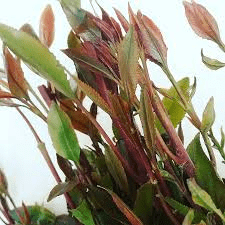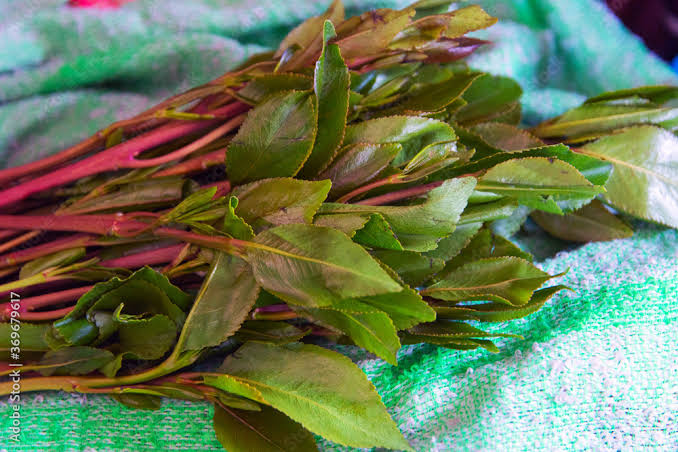Khat, scientifically known as Catha edulis, is a plant with a rich history of use in various cultures for its stimulating and medicinal properties. In this comprehensive guide, we will delve into the botanical description, geographic distribution, chemical composition, harvesting and processing methods, medicinal health benefits, usage methods, potential side effects, scientific research and studies, safety precautions, and frequently asked questions about Khat. Let’s explore the world of Khat and uncover its intriguing properties.
The Botanical Description of Khat
Khat, or Catha edulis, is an evergreen shrub or small tree that belongs to the Celastraceae family. It is native to the Horn of Africa and the Arabian Peninsula. The plant has distinctive characteristics:
1. Leaves: The leaves of Khat are glossy, elliptical, and dark green. They are approximately 5-10 centimeters in length and 1-4 centimeters in width.
2. Flowers: Khat produces small, white or yellow flowers with five petals. These flowers are clustered in axillary inflorescences.
3. Fruits: The fruits of Khat are reddish-brown capsules containing seeds. These capsules are about 1.5-3 centimeters in length.
4. Growth Habit: Khat is a woody plant that can grow up to 10 meters in height under optimal conditions.
5. Preferred Climate: This plant thrives in regions with a subtropical to tropical climate, where it can receive an adequate amount of rainfall.
The Geographic Distribution of Khat
Khat is primarily cultivated and consumed in specific regions of East Africa and the Arabian Peninsula. Its distribution is centered in countries such as:
1. Ethiopia: Khat is deeply rooted in Ethiopian culture and is commonly grown and consumed in various regions of the country.
2. Kenya: In Kenya, especially in regions like Meru and Embu, Khat cultivation is widespread.
3. Yemen: Yemen has a long history of Khat use, and the plant is an integral part of social and cultural activities.
4. Somalia: Khat is a significant cash crop in Somalia, with a substantial portion of the population involved in its cultivation and trade.
5. Djibouti: Khat is widely available and consumed in Djibouti, often as a social stimulant.
6. Saudi Arabia: While Khat is not legal in Saudi Arabia, its consumption still occurs in certain regions.
The Chemical Composition of Khat
Khat contains various compounds, with the most notable being cathinone and cathine. These alkaloids are responsible for the plant’s stimulant effects. The chemical composition of Khat also includes:
1. Cathinone: This psychoactive alkaloid is the primary stimulant in Khat. It has amphetamine-like properties and can induce feelings of euphoria, increased alertness, and energy.
2. Cathine: Cathine is another alkaloid present in Khat, although it is less potent than cathinone. It contributes to the plant’s stimulating effects.
3. Tannins: Khat contains tannins, which can have astringent properties and may contribute to its bitter taste.
4. Flavonoids: Flavonoids are compounds with antioxidant properties found in Khat.
5. Terpenoids: Some terpenoids have been identified in Khat, but their specific effects are not well-documented.
The Harvesting and Processing of Khat
Khat leaves are typically harvested from the plant and consumed fresh. The process involves the following steps:
1. Harvesting: Farmers pick the young leaves and shoots of the Khat plant early in the morning, as this is when the cathinone content is highest.
2. Bundling: The harvested leaves and shoots are bundled together for transportation and sale.
3. Chewing: Consumers usually chew the fresh leaves and shoots to release the cathinone and cathine, which are absorbed through the oral mucosa.
4. Drying: In some regions, Khat leaves are dried for preservation and can be consumed in this form as well.
Read Also: Cocoyam Inflorescence: Economic Importance, Uses, and By-Products
The Medicinal Health Benefits Of Khat (Catha edulis)

Khat has a history of traditional use for various medicinal purposes. While its stimulating effects are well-known, it has also been employed for its potential health benefits:
1. Energy and Alertness: Khat is valued for its ability to increase energy levels and alertness, making it a traditional remedy for combating fatigue.
2. Appetite Suppression: Some individuals use Khat as an appetite suppressant, which can aid in weight management.
3. Digestive Aid: Khat has been employed to alleviate digestive issues such as indigestion and constipation.
4. Mood Enhancement: The cathinone in Khat may induce feelings of euphoria and improved mood, which has contributed to its cultural and social use.
5. Mild Analgesic: In some cultures, Khat has been used for its mild pain-relieving properties.
6. Cognitive Enhancement: Users have reported increased focus and mental clarity when chewing Khat.
It’s important to note that the medicinal use of Khat is a topic of debate and study, and its effects can vary from person to person.
The Methods of Usage to Achieve the Provided Health Benefits Of Khat (Catha edulis)
The traditional method of using Khat is by chewing the fresh leaves and shoots. Here’s how it’s typically consumed:
1. Chewing: Users chew the leaves and shoots to release the active compounds cathinone and cathine. The juices are absorbed through the mucous membranes of the mouth.
2. Duration: The effects of chewing Khat can last for several hours, with users experiencing increased energy and alertness.
3. Social Activity: Khat chewing is often a social activity, with individuals gathering to share the experience.
4. Fresh Consumption: Fresh Khat leaves are preferred for their potency, but dried leaves are also used, especially in regions where fresh leaves are not readily available.
5. Infusions: In some cultures, Khat leaves are used to make infusions or teas for a milder stimulant effect.
The Side Effects Of Using Khat Medicinal Plant
While Khat has potential benefits, it also comes with a range of side effects, especially when used in excess. Some common side effects include:
1. Insomnia: Khat’s stimulating properties can lead to difficulty falling asleep and staying asleep.
2. Increased Heart Rate: Users may experience an elevated heart rate, which can be concerning for individuals with heart conditions.
3. High Blood Pressure: Khat can raise blood pressure, posing risks for individuals with hypertension.
4. Anxiety and Restlessness: Excessive consumption of Khat can lead to heightened anxiety and restlessness.
5. Digestive Issues: Some users may experience digestive problems, including nausea and constipation.
6. Addiction: Regular use of Khat can lead to dependence and addiction, especially due to the cathinone content.
Read Also: 26 Medicinal Health Benefits Of Cayaponia tayuya (Tayuya)
The Scientific Research and Studies of Khat (Catha edulis)

Scientific research on Khat has primarily focused on its chemical composition, pharmacological effects, and potential health risks. Some key findings include:
1. Stimulant Properties: Studies have confirmed Khat’s stimulant effects, primarily attributed to cathinone.
2. Psychological Effects: Research has explored the psychological impact of Khat use, including its effects on mood, cognition, and behavior.
3. Health Risks: Studies have highlighted potential health risks associated with chronic Khat use, such as cardiovascular issues and addiction.
4. Traditional Use: Ethnobotanical studies have documented the traditional uses of Khat in different cultures.
The Safety Precautions and Recommendations In Using Khat (Catha edulis) Medicinal Plant
If you choose to use Khat for its potential benefits, it’s essential to do so responsibly and be aware of safety precautions:
1. Moderate Use: Avoid excessive consumption of Khat to minimize the risk of side effects and addiction.
2. Monitor Health: Individuals with preexisting health conditions, especially cardiovascular issues, should consult a healthcare provider before using Khat.
3. Avoid Mixing: Refrain from combining Khat with other stimulants or substances that can interact negatively.
4. Stay Hydrated: Ensure you drink enough water to prevent dehydration, as Khat can have a diuretic effect.
5. Legal Considerations: Be aware of the legal status of Khat in your region, as it may vary.
FAQs About Khat (Catha edulis) Medicinal Plant
1. Is Khat legal in the United States?
Khat is classified as a controlled substance in the United States, making its possession and sale illegal.
2. Can Khat be addictive?
Yes, Khat has the potential for addiction, primarily due to its cathinone content. Users may develop a psychological dependence.
3. Are there any known interactions between Khat and prescription medications?
Khat can interact with certain medications, especially those that affect the cardiovascular system. It’s crucial to consult a healthcare provider if you’re taking prescription drugs.
4. What are the long-term health risks of Khat use?
Long-term use of Khat can lead to various health risks, including cardiovascular problems, dental issues, and mental health concerns.
5. Can pregnant or nursing women use Khat?
It is not advisable for pregnant or nursing women to use Khat, as it may have adverse effects on fetal and infant health.
6. Is Khat cultivation sustainable?
Unsustainable cultivation practices, including deforestation, have raised concerns about the environmental impact of Khat farming in some regions.
7. Can Khat be used as a performance enhancer?
Some individuals use Khat to enhance focus and energy for tasks or work, but its use for this purpose is controversial and not recommended.
8. What is the cultural significance of Khat in East Africa and the Arabian Peninsula?
Khat plays a significant role in social and cultural gatherings, often used as a means of relaxation and socializing.
9. How is Khat typically consumed in Yemen?
In Yemen, Khat is often chewed by individuals of all ages, and it is a common social activity, especially in the afternoons.
10. Are there any traditional rituals associated with Khat use?
Some cultures have traditional rituals and ceremonies that involve the consumption of Khat, often as a form of celebration or bonding.
11. Does Khat have any role in traditional medicine practices?
Khat has been used in traditional medicine for its potential medicinal properties, but its use is not standardized or widely accepted in modern healthcare.
12. Are there any known cases of Khat-related health emergencies?
There have been reports of Khat-related health emergencies, including cases of severe cardiovascular issues and mental health crises.
13. Can Khat be used as a natural remedy for depression or anxiety?
While some users report mood enhancement with Khat, its use for mental health conditions is not supported by scientific evidence and may pose risks.
14. How can Khat be stored for long-term use?
If you need to store Khat for an extended period, it’s best to dry the leaves and keep them in an airtight container in a cool, dark place.
15. What is the legal status of Khat in Ethiopia?
In Ethiopia, Khat is legal and deeply ingrained in the culture and economy, often referred to as “chat.”
16. Is Khat cultivation sustainable in the long run?
Unsustainable farming practices, including deforestation, have raised concerns about the environmental impact of Khat cultivation in some regions.
17. Can Khat be used as a performance enhancer?
Some individuals use Khat to enhance focus and energy for tasks or work, but its use for this purpose is controversial and not recommended.
18. Are there any potential economic benefits to Khat cultivation?
Khat cultivation can provide economic benefits to farmers in regions where it is legal and culturally accepted, contributing to livelihoods and trade.
19. Is Khat consumption associated with specific rituals or traditions in Yemen?
In Yemen, Khat chewing is often accompanied by traditional rituals and social gatherings, serving as a means of relaxation and bonding.
20. Is Khat use associated with any specific health risks in the long term?
Long-term Khat use has been linked to various health risks, including dental problems, cardiovascular issues, and mental health concerns.
21. Can Khat be used to manage attention disorders like ADHD?
There is no scientific evidence to support the use of Khat in managing attention disorders like ADHD, and it is not recommended for this purpose.
22. What are the potential legal consequences of possessing or using Khat in countries where it is prohibited?
Possessing or using Khat in countries where it is illegal can result in legal consequences, including fines and imprisonment.
